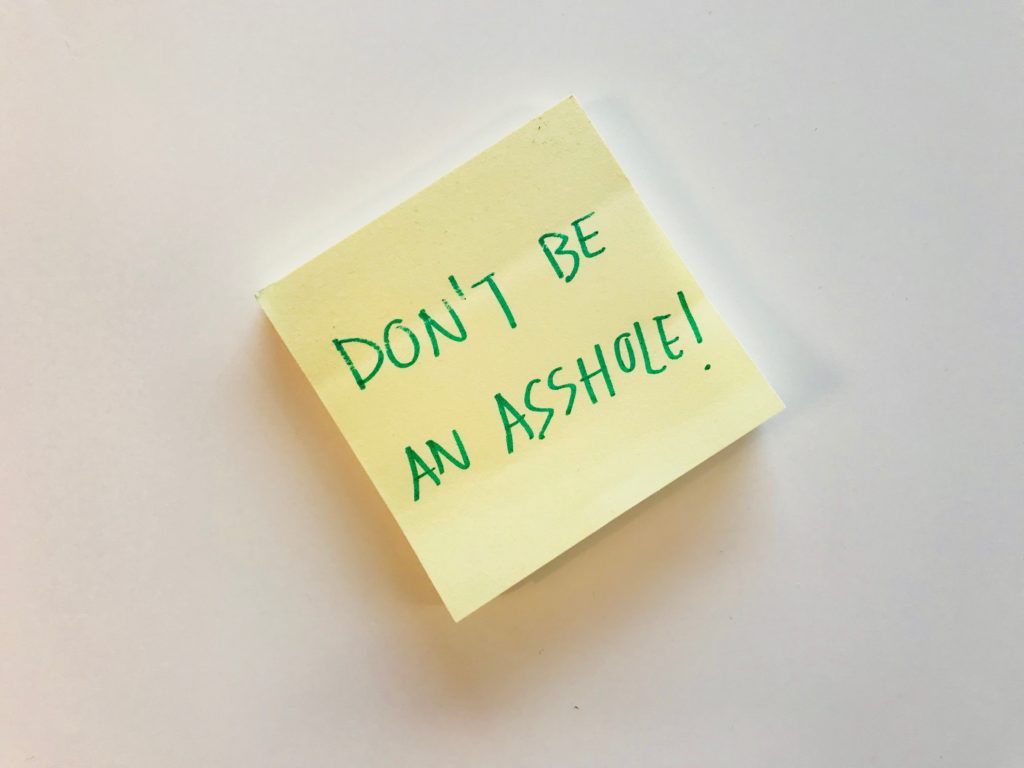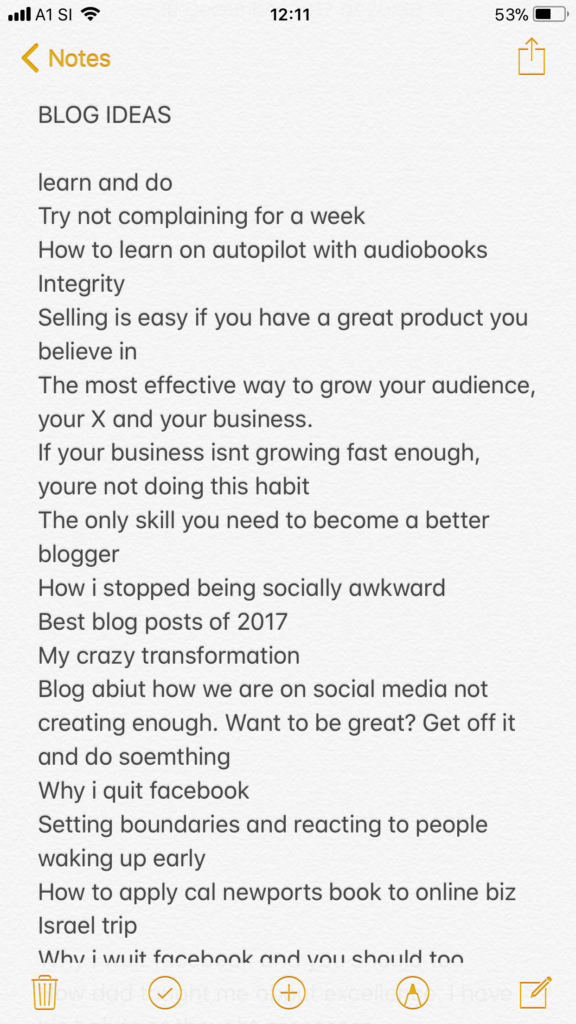
I know you want to make 2019 an amazing year.
But how can you do that…
-
- Without setting New Year’s resolutions that you don’t stick to?
-
- Without spending 20 hours creating a 30-page yearly review that you never review?
- Without not doing a yearly review at all because you’re too busy working (or relaxing from work and spending time with your family)?
I’ve tried a lot of different things when it comes to reviewing the past year and planning out the next year.
I’ve tried the New Year resolutions. They never worked for me for longer than a few weeks when I forgot about them and moved on with my life.
I tried doing the 30-page planning documents, and while they worked well for a lot of my friends, I just never ended up using and reviewing them for longer than a few weeks.
This year, I realized that I didn’t want to spend 20 hours reviewing my year and planning the next year.
I decided I’d rather spend the 20 hours during the holidays skiing in the mountains, relaxing in a spa, and night-tobogganing after a crazy Apres Ski party:

I spent the holidays skiing in Solden, Austria – it was incredible!
But when I came back home, I felt like something was missing.
I recovered REALLY well during my vacation and felt more relaxed than I did in months, but I lacked a sense of clarity and direction for 2019, and it bugged me.
As I had only a few days left before I got back to work (most of which were spent preparing for a NYE party, partying late into the night and then laying hungover in bed next day watching Christmas movies and eating junk food), I wanted to find a way to make 2019 awesome without spending 20 hours doing a gigantic yearly review.
Instead, I wanted to plan my year in a way that:
-
- Is FUN and exciting for me
-
- I’d accomplish what I wanted to accomplish
-
- Is simple and doesn’t require a huge time commitment
-
- I would have crystal clear focus for the year
- I could easily review my progress every week and correct course
To have even more fun with it, I decided to create my own annual review system that I call The Lean Review.
And of course, because I’m a spreadsheet nerd, I created a spreadsheet to go with it.
Today, I’ll share this full system with you – so you can use it to plan out your 2019 in a matter of minutes, rather than hours (and have fun while doing it).
Let’s dive in!
The Lean Review
The Lean Review includes just 5 steps:
-
- The 5-Minute Clarity Session
-
- Bronze, Silver and Gold Medals
-
- The Lean Review Dashboard
-
- The 2-Minute Weekly Review
- Support & Accountability Systems
With the exception of the last step (the support and accountability systems) which can take a bit longer (but is optional), all of the steps within this process take only a few minutes to complete – and they’re actually FUN and EXCITING, not just another thing that you HAVE to do (but don’t have the time for).
So let’s get started!
Step #1: The 5-Minute Clarity Session
There are quite a few things I don’t like about the ultra-long annual reviews:
-
- They take A LOT of time (that could be spent relaxing and recharging)
-
- They force you to review and work on ALL areas of your life (which can be counterproductive as it splits your focus into too many directions)
- They can be dreadful and tiring (rather than fun and exciting)
So this year, when I did my planning, I asked myself:
“What’s the 80/20 approach to doing an annual review and planning out my next year? And how could I do it in under 5 minutes?”
I ended up asking myself just 3 simple questions:
-
- What are some achievements that would make this year AMAZING?
-
- Which of these achievements are in my control?
- “Do these achievements feel EXCITING, “MEH” or TOO MUCH?”
Let me provide some more context on each of these questions and how I used them to get more clarity on what I wanted from 2019:
What are some achievements that would make this year AMAZING?
Notice how I’m not saying “goals” – I’m saying achievements.
I don’t want to just set random “goals” that sound good on paper, feel like I “should” work on, and I’m not actually all that excited about.
Instead, I’m asking myself what can I ACHIEVE this year that would make this year amazing.
This helped me come up with really cool challenges that would challenge me and stretch me to achieve things I have never achieved before (and would make this year a year to remember).
Which of these achievements are in my control?
When I thought about my achievements, I made sure that they were actually in my full control, and avoided achievements that were not in my full control.
For example:
-
- I didn’t focus on losing X amount of body weight, instead I focused on going 60 days without a cheat meal.
-
- I didn’t focus on getting X new e-mail subscribers, instead I focused on writing 1,000,000 words in a year.
- I didn’t focus on hitting X amount of revenue, instead I focused on putting in 1,000 hours of quality work this year.
I intentionally focused on tracking my hard work, not results.
That’s because if you focus on results…
-
- And something goes exceptionally well (a blog post goes viral and you get 2,000 new e-mail subscribers from it), then you can hit your goal and stop working hard
- If something goes really badly (a few blog posts don’t get you almost any e-mail subscribers), you can get really discouraged by the lack of results, even though you could be doing all the right things
I wanted to avoid this emotional roller coaster around things that aren’t fully in my control, and instead focused on making progress on things that I CAN control, knowing that they’ll bring the results that I want in the long run.
Do these achievements feel EXCITING, “MEH” or TOO MUCH?
When I brainstormed my achievements, I came up with a lot of different things, from writing 1,000,000 words in a year, to going for a walk 5 times a week, to hosting 12 dinner parties in a year.
As my list grew to around 15 goals, I realized I quickly felt more and more pressure, rather than excitement when I looked at the list. That’s when I knew that I had to cut it down and make it leaner.
To do that, I simply looked at all of my achievements and asked myself:
-
- Does this achievement feel really EXCITING?
-
- Does it feel “MEH, KIND OF NICE”?
- Does it feel like TOO MUCH?
For example, while I liked the idea of hosting 12 dinner parties in a year, it didn’t really excite me, it just felt like “meh”.
And when I thought about learning to cook 100 new dishes in a year, I just felt like it was way too much, and not really what I wanted to achieve this year.
I then eliminated all of the achievements that didn’t feel EXCITING and created a Lean List of 6 achievements that I stuck with.
How many achievements should you choose?
Should you choose 1 achievement? 3? 5? 10?
Should you focus on achievements in your business, health, or in personal life? Or all of them?
I don’t think there’s a “one size fits all” answer to this question.
Instead, I like to think about it this way:
-
- You can look at the list, and if it feels EXCITING (and not like TOO MUCH or TOO LITTLE), you have a good length of the list
- You can always add or remove items from the list later during one of the weekly reviews IF you begin to feel like it’s too much or too little
I personally chose 6 achievements because that felt just right to me after I trimmed down my list. I could have easily gone with 4 or 8 items and it probably wouldn’t make a huge difference, and I know I might add or remove something from the list down the line.
Why you should only spend 5 minutes on this task
I call this task the “5-minute clarity session” because if you take just a few minutes for this task, you:
-
- Won’t get bogged down in it too much
-
- You’ll usually come up with the ideas that are on top of mind
- You’ll get 80% of great ideas in a fraction of the time
What about the other 20% that you’re “missing” with this approach?
Well, chances are that if you have another really good achievement in the back of your mind, it will come to you over the next few days / weeks.
Then, you can just add it to your Lean Review System (which will literally take 30 seconds).
How I did it:
Here’s how I went through my clarity session.
First, I brainstormed all the cool achievements I could achieve this year:
-
- Write 1,000,000 words
-
- Put in 1,000 hours of high quality work
-
- Go on 5 walks every week
-
- Go on 12 long hikes
-
- Host 12 dinner parties
-
- Publish 50 posts on my website
-
- Save $100k
-
- Go for 60 days without cheat meals
-
- Have 10 collaborations with other bloggers
-
- Read 100 books
- Get 200 members in my writing membership
Then, I cut out all the things that didn’t feel as exciting, and was left with:
-
- Write 1,000,000 words
-
- Put in 1,000 hours of high quality work
-
- Read 100 books
-
- Go for 60 days without cheat meals
-
- Save $100k
- Get 200 members in my writing membership
Notice there’s no goals related to relationships, just one goal related to health, and no goals related to family, vacations, etc.
That doesn’t mean I won’t be working on those areas this year – it just means that some of these are going really well right now already, and I don’t have anything major I want to achieve (which might change throughout the year).
Instead of mindlessly filling up my list with 20 achievements just to cover every single area of my life (which can feel like too much and become a chore to keep up with), I’d rather have focus and do really well at the things I DO decide to achieve.
YOUR TURN:
Take 5 minutes and brainstorm all the cool achievements you could achieve this year.
Then, go through the list and trim it down to create a Lean List of achievements that feel really exciting for you.
STEP #2: Bronze, Silver and Gold Medals
If you read through my achievements above you might be thinking “You’re crazy! If you really write 1,000,000 words, read 100 books AND put in 1,000 hours of work, you won’t have a life!”.
You’re right. I probably won’t achieve all of those, and that’s totally OK.
A lot of us love this idea of setting “stretch goals”, “impossible goals”, or “insane goals”. It gets us really excited for the moment, and motivated for a few weeks.
But how often do we actually hit those impossible goals, and how often do we just forget about them and move on to something else when life gets in the way, even though we were actually doing really well?
For example, I could give myself an achievement to read 100 books in a year, which would mean reading roughly 8 books a month. If I only read 4 books in January, I might start feeling like this achievement is “too much”, “fall behind” and give up on the challenge.
But that’s nonsense. If I read 4 books, that’s great as I got a lot of new ideas for my business and I’m expanding my knowledge. Why would I feel crappy about it and not keep going?
To combat this issue, I developed the Medal System for my achievements.
Here’s how it works:
-
- The Bronze Medal is an achievement that might slightly stretch my current capabilities, and will feel GOOD if I achieve it this year.
-
- The Silver Medal will stretch my current abilities more, require more discipline and be more exciting, but won’t feel like I need to sacrifice everything to achieve it. I will feel GREAT if I achieve it this year.
- The Gold Medal is the “impossible” achievement that might almost feel out of reach, but I know that it’s possible deep down if I put all of my focus, heart and work into it. It will feel INCREDIBLE if I achieve it this year.
Because it’ll be relatively easy to keep up with my Bronze Medal achievements, I know I’ll feel like I’m making good progress most of the weeks when I review how I’m doing, which will help me keep the momentum going.
But even if I’ll be doing well, I know that the competitor in me will want to push me harder and harder so I can reach the Silver Medal and Gold Medal benchmarks.
My goal isn’t to get 6 Gold Medals this year – but I know that even if I hit 1 or 2 (or just get a few Silver Medals), my year will be really amazing.
I love these challenges because they help me change my behavior and make slightly better decisions every day.
For example:
-
- “Sticking with a diet” is less exciting to me than to keep a streak of no cheat meals going for just another few days so I can hit the next medal.
-
- Instead of listening to music while driving to the gym, I can make a choice to listen to an audiobook and get closer to hitting my Silver and Gold Medal benchmarks that week.
- Instead of watching Netflix over the weekend I can make a choice to get some writing done or read a book, to get closer to hitting my desired benchmarks.
If you love a challenge, you’ll love having these benchmarks in your life!
How I did it:
Here’s how I created my own Medals for different achievements (Bronze, Silver, Gold):
-
- Savings: 20k, 50k, 100k
-
- Words Written: 200k, 500k, 1m
-
- High Impact Work Hours: 500, 750, 1000
-
- Books Read: 20, 50, 100
-
- Membership Members: 50, 100, 200
- Days Without Cheat Meals: 14, 30, 60
YOUR TURN:
Take a few more minutes to create bronze, silver and gold medals for your achievements – and have fun with it!
STEP #3: The Lean Review Dashboard
I love spreadsheets.
I have spreadsheets for everything – from tracking my diet, writing, work hours, my content strategy, and more.
So when I went through my Lean Review process, I knew I wanted to have this one place where I could visually see how I’m progressing towards all of my goals in a matter of seconds (and see exactly where I want to do better).
That’s how I created The Lean Review Dashboard.
I created a dashboard where I can keep track of all of my achievements (and how close I am to reaching the Bronze, Silver and Gold Medals for the year):

I created a way to track my progress on a weekly basis for 52 weeks of 2019:

And I even created weekly benchmarks for each of the medals, so you can see if you’re on track to hit them this year:

90% of this dashboard works fully automatically.
All you need to do is:
-
- Input your achievements
-
- Define Bronze, Silver and Gold medals
- Spend 2 minutes every week updating your scores
…and that’s it!
All the other numbers like weekly benchmarks for different medals and your progress towards those benchmarks will get calculated automatically.
Setting up this dashboard literally takes 2 minutes, as you already have all the data for it from the previous steps.
You can download the Lean Review Dashboard through the box below free of charge (it’s on me – consider it a gift to make 2019 really amazing!), and I’ll also send you a quick instructional video with it to show you exactly how to use it.
YOUR TURN:
Download The Lean Review Dashboard through the link above, watch the instructional video and set it up to fit your achievements (this will take less than 2 minutes).
STEP #4: The 2-Minute Weekly Review
Have you ever tried doing a weekly review?
You know, one of those reviews where you sit down for 30 minutes every week, go over every goal you set, analyze what went, well, what didn’t go well, and make a plan for the future?
I know I tried keeping up with a weekly review habit multiple times in the past, but it always became a chore after a few weeks.
If I did the review at the end of the week, I felt tired and just wanted to finish working for the week.
If I did it at the beginning of the week, I felt like I was wasting time when I really wanted to be working.
Then, I felt guilty for not doing the weekly review, and in the end having one hurt me more than it helped me.
That’s why I stopped doing a weekly review in a traditional form.
I still have a few review elements in my support accountability systems (like checking in with my nutritionist 2x/week or working with a thinking coach 1x/week) that automatically happen every week, but I’m not using a review where I sit down and reflect on my life every week.
Instead, I decided to design a weekly review that’s easy, fun, and takes under 2 minutes every week.
All I’ll do every week is enter 6 numbers in The Lean Review Dashboard to see how I’m doing with my achievements:

Then I’ll compare those numbers to the Bronze, Silver and Gold Medals to see how I’m doing:

For example, I’ll update how much money I have in my savings account each week, I’ll calculate the number of words written so far, how many hours I worked this past week, etc. and add these numbers to the dashboard.
Then I’ll check if I’m on track to hit Bronze, Silver or Gold benchmarks this year.
And that’s it!
I won’t answer 10 different questions around each of my achievements thinking about how to do better at 10 different things.
Instead, if there’s an achievement where I really feel like I want to do better, I’ll use or revisit my support & accountability systems to do better next week – but that won’t include 30 minutes of journaling.
This might not feel thorough enough to you, but I do believe that it serves the 80/20 rule really well.
Of course, if I’ll feel like “crap, I didn’t get any writing done this week”, I’ll AUTOMATICALLY think about what I can do better next week and make some changes. It will just happen – it won’t be a chore that I have to do every week.
So I’ll work on “correcting course” when I want to, but won’t feel obliged to do so every single week, especially if things are going well.
How I remember to actually do the review every week
Right now that I’ve started using this system, using it is easy as it’s on top of my mind. However, I know that using it 3 months from now, or when life gets in the way might not be as easy, and there might be times when I forget to use it.
To prevent that from happening, I set up a simple calendar reminder that reminds me to update my dashboard every Friday. This isn’t a fixed appointment and I can move it to a Saturday or Sunday (which I likely often will), but I just want it to be there so I don’t forget to do my 2-minute review.
I also created three shortcuts that help me access the weekly review easily every week:
-
- I set The Lean Review Dashboard as my homepage in my browser
-
- I bookmarked The Lean Review Dashboard in my bookmarks bar
- I linked The Lean Review Dashboard in my google calendar event description
This way I can access the dashboard at any time with a single click and make it super easy for me to do my weekly review.
Some people also prefer to use the Google Calendar reminder rather than a Google Calendar event to create reminders like this.
The differences are that:
-
- A Google Calendar Event can have a description (so you can link to your LRD from it), but can be easy to forget if you “miss it”.
- A Google Calendar Reminder doesn’t have a description box, but doesn’t disappear until you mark it as done (it moves to the next day automatically), so it’s harder to miss.
Either can work well – I suggest just picking one and going with it (you can always change it in the future).
YOUR TURN:
You can set up your own weekly review system by:
-
- Linking the LRD (Lean Review Dashboard) in the calendar event description
-
- Bookmarking the LRD in your browser
-
- Setting LRD as a homepage in your browser
- Simply doing the 2-minute review every week
STEP #5: Create Your Support & Accountability Systems
If you followed all the steps above, you’ve successfully completed The Lean Review and have a bulletproof system and bullet journal layout ideas set up so that you can keep up with your achievements throughout 2019.
Even without going through this last step, you can already get started with tracking your progress towards achievements and have an amazing 2019.
Nice work!
Now, let’s talk about one last step.
This final step of The Lean Review will make it easier for you to actually hit your Bronze, Silver, and Gold Medal benchmarks and help you “correct course” along the way.
This isn’t a step that you have to go through once though – it’s an ongoing process that you can iterate through and evolve over time (though you can get started with it today if you want to).
It’s not something you HAVE to do, it’s something you’ll AUTOMATICALLY do when you’ll want to make better progress towards your benchmarks.
As you create your achievements and bench for the year, you’ll want to ask yourself questions like:
-
- “How can I make it EASIER for me to reach my benchmarks?”
-
- “How can I go from a Bronze Medal to a Silver Medal next week?”
- “Where and how can I do better than I’m doing right now?”
And from my experience, the easiest way to actually ask yourself those questions on a regular basis (and improve your progress towards your achievements) is to create some sort of a support & accountability system for each of your benchmarks.
For example, when I first started going to the gym, it was extremely tough for me to work out regularly.
Then I hired a personal trainer and all of a sudden, I went to the gym 3-4/week consistently for a YEAR.
That’s because even when the times were tough, my trainer was still there waiting for me, but also supporting me and encouraging me to keep going when I was swamped with work, felt tired or just didn’t feel like working out.
Or, in order to stick with my diet better, I hired a nutritionist that I have to send updates to 2x/week so that he can help me modify my diet as needed (and keep me on track with it).
To create your own support & accountability system, you don’t necessarily have to hire experts to keep you accountable (though I highly encourage you to do it if you CAN afford it).
You can:
-
- Find a gym buddy to hit the gym together
-
- Join a book club to read more books
-
- Create a writing tracker where you track your writing
-
- Join a cooking class to cook more
- Track all of your work in a spreadsheet so you can improve your work routines and accomplish more
Even just having the 2-minute review for your achievements already counts as having a basic self-accountability system for all of your achievements and will help you do better than by not having any system at all.
On a more general level, there are a lot of different levels of support and accountability that you can think about:
-
- Hiring an expert or a coach to help you and keep you accountable 1on1
-
- Joining a group coaching / training program
-
- Joining a community or a club
-
- Joining an online membership
-
- Taking an online course
-
- Getting an app
-
- Taking a class
-
- Finding a mastermind group or accountability buddy
- Creating a tracking system that keeps you accountable
Some of these are more expensive, others are more accessible. Some involve more active, others more passive accountability. Some keep you accountable to yourself, others to others.
If the achievements you’re working on are really important to you, I recommend setting up the best support & accountability systems you can afford for each of them, then iterating through them until they work well for you.
For example, you could always just try tracking your diet in a spreadsheet to see if that helps you make good progress with it. If that’s not enough, you could consider finding a diet buddy or hiring a nutritionist, until you find something that works really well for you.
You don’t have to set up all of these systems right away, but you can try to create more and more systems for yourself throughout the year, with the goal of eventually having a bulletproof system for each of the achievements you want to achieve.
Some of these systems might be more hands-on and more expensive (like hiring a 1on1 coach), while others might be a lot simpler (like having a spreadsheet where you track your work every week).
It’s important to note that not all of these systems will work for you, so I recommend just trying them up, then tweaking / replacing them after a few weeks if they don’t end up working as well as you wanted them to.
You can set up these systems when you feel like you’re plateauing and not progressing as well as you want to, when you feel like you fall off track too often, or simply when you have some extra money to invest in yourself.
How I did it:
Here are the support & accountability systems I’m currently using to make progress on my achievements:
-
- Savings: I have frequent conversations with my girlfriend about money and how my savings are going
-
- Cheat meals: I have a nutritionist that keeps me on track + I track my cheat meals (and how many days I haven’t had one) in a spreadsheet
-
- Writing: I track all of my writing in a spreadsheet + have weekly conversations about writing with my thinking coach
-
- Working hours: I track my work hours in a spreadsheet + have weekly conversations about work with my thinking coach
-
- Membership members: I update my Lean Dashboard whenever a new member joins the program
- Books: I don’t have a system here yet, but will likely create a spreadsheet to track my reading that worked well for me in the past (or potentially join a book club)
I know that these systems aren’t perfect, and in an ideal world I would definitely have more support accountability, especially with reading books, my membership, my work hours and writing – but it’s a solid start and I’ll see where it gets me.
Then, throughout the year I can change my systems or invest more time or money in better systems if I feel like I’m plateauing or not making as much progress as I want to.
YOUR TURN:
Here come the final action steps. You can go through these now, or simply keep them on top of mind as you do your weekly reviews and notice that you’re not hitting your benchmarks.
For each of your benchmarks:
-
- Write down your CURRENT support & accountability systems
-
- Think about how you can create a better system TODAY
- Think about what the IDEAL system would look like
And then create, change and improve your systems throughout the year as needed.
Conclusion
That’s it!
To fully implement everything you learned from this post:
-
- Create your Lean List of achievements for 2019
-
- Create Bronze, Silver and Gold benchmarks for each of them
-
- Download The Lean Review Dashboard through the box below
-
- Set up The 2-Minute Review in your calendar
-
- Create shortcuts to your Lean Review Dashboard
- Create and improve Support & Accountability Systems throughout the year
And except from the last step, you should be able to do all of this in under 20 minutes.
I hope you’ll find this system as helpful as I’m finding it – and if you do end up using it, let me know how it helped you!
What about you? What kind of a review system are you using for 2019?














